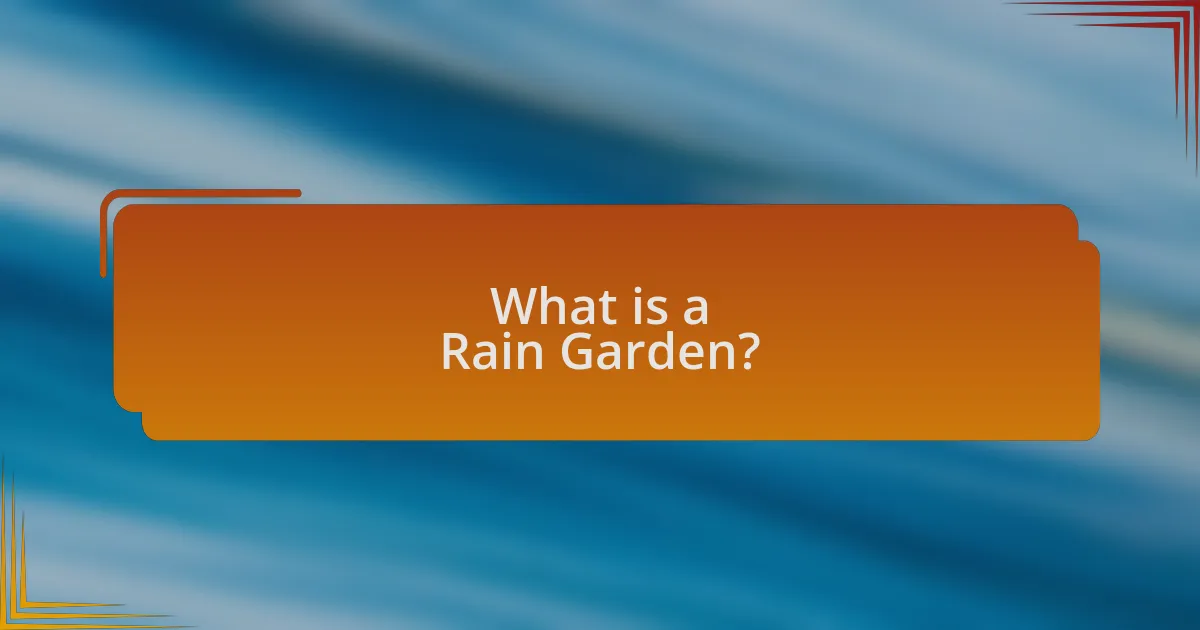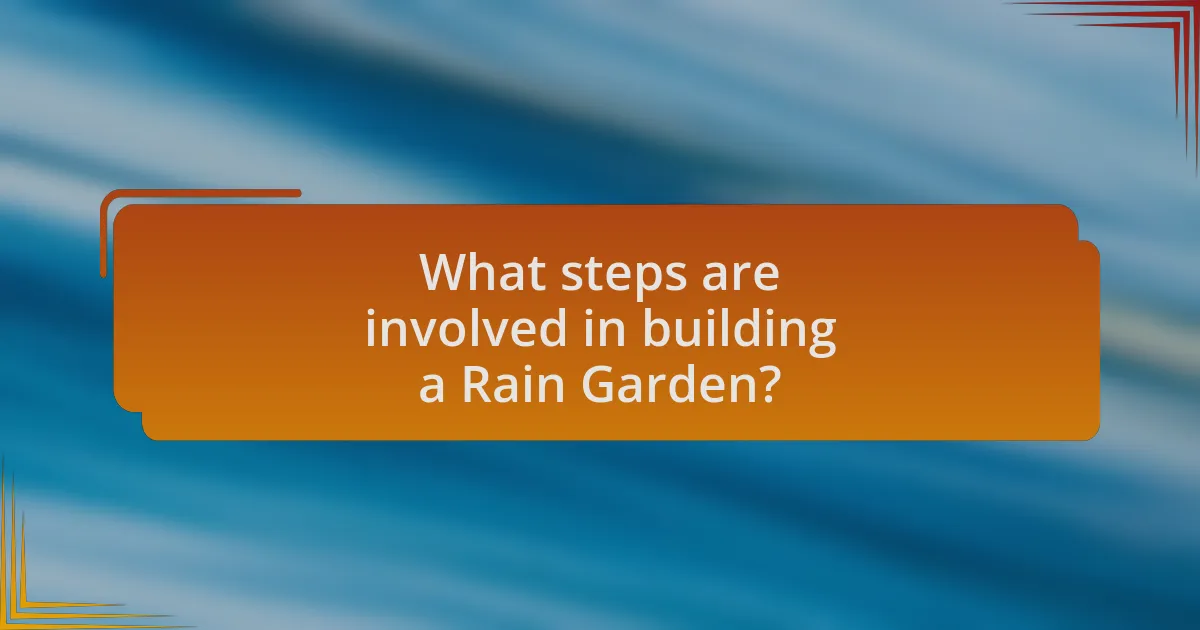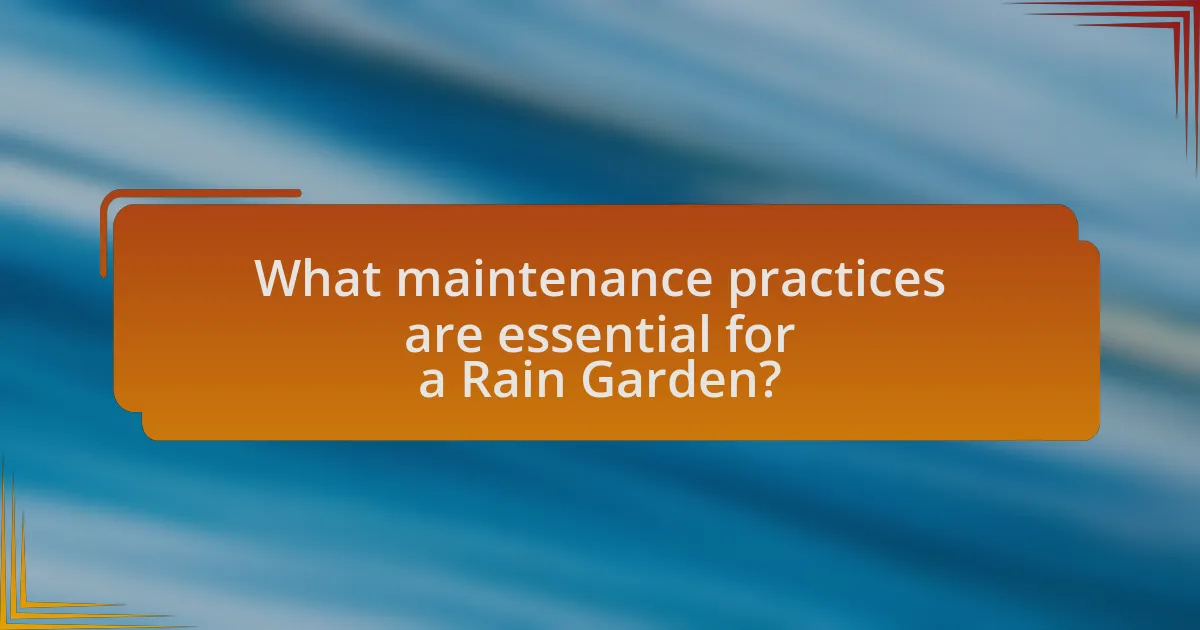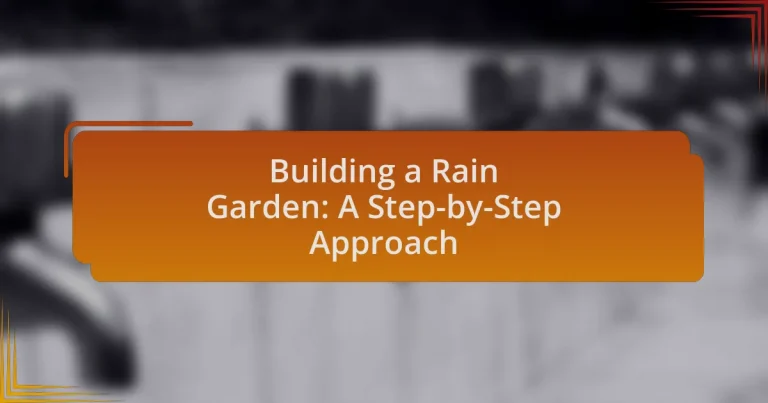A rain garden is a strategically designed planted depression that effectively manages stormwater runoff by allowing water to infiltrate into the ground. This article provides a comprehensive guide on building a rain garden, detailing its function in stormwater management, key components, and the environmental benefits it offers, such as improved water quality and enhanced biodiversity. It outlines essential steps for construction, including site selection, soil preparation, and plant selection, while also addressing maintenance practices to ensure the garden’s long-term effectiveness. Additionally, the article discusses troubleshooting common issues and best practices for creating an aesthetically pleasing and functional rain garden.
What is a Rain Garden?

A rain garden is a planted depression designed to manage stormwater runoff by allowing water to soak into the ground. This type of garden typically consists of native plants and soil that can absorb excess rainwater, reducing flooding and improving water quality. Rain gardens help filter pollutants from runoff and recharge groundwater, making them an effective solution for sustainable landscaping and stormwater management.
How does a Rain Garden function in stormwater management?
A rain garden functions in stormwater management by capturing and absorbing rainwater runoff from impervious surfaces, such as roofs and driveways. This process reduces the volume of stormwater that enters drainage systems, thereby minimizing flooding and erosion. Rain gardens are designed with native plants and soil that promote infiltration, allowing water to percolate into the ground rather than flowing into storm drains. Studies have shown that rain gardens can reduce runoff by up to 90%, effectively filtering pollutants and improving water quality before it reaches local waterways.
What are the key components of a Rain Garden?
The key components of a Rain Garden include a shallow depression, native plants, soil amendments, and an appropriate drainage system. A shallow depression is designed to collect and temporarily hold rainwater, allowing it to infiltrate into the ground. Native plants are essential as they are adapted to local conditions, require less maintenance, and support local wildlife. Soil amendments, such as compost or sand, improve drainage and enhance the soil’s ability to filter pollutants. An appropriate drainage system ensures that excess water can flow away from the garden, preventing flooding and erosion. These components work together to effectively manage stormwater runoff and promote ecological health.
How does soil type influence a Rain Garden’s effectiveness?
Soil type significantly influences a Rain Garden’s effectiveness by affecting water infiltration, retention, and drainage. Sandy soils allow for rapid drainage, which can lead to insufficient water retention for plants, while clay soils retain water but may cause poor drainage, potentially leading to plant root rot. Loamy soils, which are a balanced mixture of sand, silt, and clay, provide optimal conditions for both water retention and drainage, making them ideal for Rain Gardens. Research indicates that the soil’s texture and composition directly impact the garden’s ability to manage stormwater effectively, as demonstrated in studies showing that well-draining soils enhance plant health and reduce runoff.
What are the environmental benefits of building a Rain Garden?
Building a rain garden provides significant environmental benefits, including improved stormwater management, enhanced biodiversity, and increased groundwater recharge. Rain gardens capture and filter rainwater runoff, reducing the volume of water that enters storm drains and minimizing flooding and erosion. They also support various plant species, which attract pollinators and other wildlife, thereby enhancing local ecosystems. Additionally, rain gardens promote groundwater recharge by allowing water to percolate into the soil, which helps maintain water levels in aquifers. These benefits contribute to healthier urban environments and improved water quality.
How do Rain Gardens improve local water quality?
Rain gardens improve local water quality by capturing and filtering stormwater runoff, which reduces pollutants entering waterways. These gardens utilize native plants and soil to absorb excess rainwater, allowing it to percolate through the soil layers, where contaminants such as heavy metals, nutrients, and sediments are naturally filtered out. Studies have shown that rain gardens can reduce runoff volume by up to 30%, significantly decreasing the amount of pollutants that reach local streams and rivers. This filtration process not only enhances water quality but also promotes groundwater recharge, contributing to a healthier ecosystem.
What role do Rain Gardens play in supporting biodiversity?
Rain gardens play a crucial role in supporting biodiversity by providing habitats for various plant and animal species. These gardens are designed to capture and filter stormwater, creating a diverse ecosystem that attracts pollinators, birds, and beneficial insects. The native plants commonly used in rain gardens are essential for local wildlife, as they offer food and shelter, thereby enhancing the overall ecological health of the area. Studies have shown that rain gardens can increase species richness and abundance, contributing to greater biodiversity in urban and suburban environments.
What steps are involved in building a Rain Garden?

To build a rain garden, follow these steps: first, select an appropriate location that receives runoff, ideally near downspouts or paved surfaces. Next, determine the size of the garden based on the area of the impervious surface contributing runoff, typically aiming for a garden that is about 20% of that area. After that, dig a shallow depression to hold water, ensuring it has a gentle slope for drainage. Then, amend the soil with organic matter to improve drainage and plant selection, choosing native plants that can tolerate both wet and dry conditions. Finally, mulch the garden to retain moisture and suppress weeds, and monitor the garden to ensure it functions effectively over time. These steps ensure the rain garden effectively manages stormwater runoff while enhancing local biodiversity.
How do you select the right location for a Rain Garden?
To select the right location for a rain garden, identify an area that receives runoff from impervious surfaces like roofs or driveways. This ensures that the rain garden effectively captures and filters stormwater. Additionally, the site should have well-draining soil to prevent standing water, ideally located at least 10 feet away from building foundations to avoid water damage. According to the University of Maryland Extension, rain gardens should be placed in a spot that is at least 6 inches lower than the surrounding area to facilitate drainage and promote water absorption.
What factors should be considered when choosing a site?
When choosing a site for a rain garden, factors such as soil type, drainage, sunlight exposure, and proximity to water sources must be considered. Soil type affects water retention and plant growth; sandy soils drain quickly while clay soils retain water. Proper drainage is crucial to prevent flooding and ensure the garden functions effectively. Sunlight exposure influences plant selection, as most rain garden plants thrive in full sun to partial shade. Additionally, the site should be located near downspouts or areas where runoff collects to maximize the garden’s effectiveness in managing stormwater.
How does proximity to existing drainage systems affect site selection?
Proximity to existing drainage systems significantly influences site selection for rain gardens. When a site is near established drainage systems, it facilitates efficient water management by allowing for better integration of the rain garden with existing infrastructure. This proximity can enhance the garden’s ability to capture and filter runoff, reducing the risk of flooding and improving water quality. Studies indicate that rain gardens located within 10 to 20 feet of drainage systems can effectively intercept and treat stormwater, making them more functional and sustainable.
What materials are needed to construct a Rain Garden?
To construct a Rain Garden, the essential materials needed include native plants, soil mix, mulch, and a barrier or edging material. Native plants are crucial as they are adapted to the local climate and soil conditions, promoting biodiversity and requiring less maintenance. A soil mix, typically composed of a blend of sand, compost, and topsoil, ensures proper drainage and supports plant growth. Mulch, such as wood chips or shredded bark, helps retain moisture and suppress weeds. Finally, a barrier or edging material, like stone or plastic, defines the garden’s shape and prevents soil erosion. These materials collectively contribute to the effective functioning of a Rain Garden in managing stormwater runoff.
What types of plants are best suited for Rain Gardens?
Native plants are best suited for rain gardens due to their adaptability to local climate and soil conditions. These plants, such as coneflowers, black-eyed Susans, and various sedges, thrive in both wet and dry conditions, making them ideal for the fluctuating moisture levels typical of rain gardens. Research indicates that native plants enhance biodiversity, support local wildlife, and require less maintenance compared to non-native species, which often struggle in these environments.
How do you determine the right soil mix for your Rain Garden?
To determine the right soil mix for your Rain Garden, you should aim for a blend that promotes drainage while retaining moisture. A recommended mix typically consists of 50% topsoil, 25% compost, and 25% sand or gravel. This combination ensures that the soil can absorb rainwater effectively while preventing waterlogging, which is crucial for the health of the plants. Research indicates that well-drained soils enhance plant growth and resilience in rain gardens, as they mimic natural conditions found in wetlands.
What maintenance practices are essential for a Rain Garden?

Essential maintenance practices for a rain garden include regular weeding, mulching, and monitoring plant health. Weeding prevents invasive species from overtaking native plants, ensuring biodiversity and proper water absorption. Mulching helps retain moisture and suppresses weed growth, while monitoring plant health allows for early detection of pests or diseases, promoting a thriving ecosystem. Regular maintenance, ideally conducted seasonally, enhances the rain garden’s functionality in managing stormwater runoff effectively.
How often should a Rain Garden be inspected and maintained?
A Rain Garden should be inspected and maintained at least twice a year, ideally in spring and fall. Regular inspections help identify any issues such as sediment buildup, plant health, or drainage problems. Maintenance tasks may include removing debris, checking for erosion, and replacing dead plants to ensure the garden functions effectively in managing stormwater runoff.
What common issues should you look for during inspections?
Common issues to look for during inspections of rain gardens include poor drainage, soil erosion, and plant health. Poor drainage can lead to standing water, which may indicate that the garden is not functioning as intended. Soil erosion can compromise the structure and effectiveness of the rain garden, while unhealthy plants may signal inadequate soil conditions or pest problems. Regular inspections should focus on these aspects to ensure the rain garden operates effectively and supports local ecosystems.
How can you effectively manage weeds and pests in a Rain Garden?
To effectively manage weeds and pests in a Rain Garden, implement a combination of mulching, plant selection, and regular maintenance. Mulching suppresses weed growth by blocking sunlight and retaining moisture, while selecting native plants that are well-adapted to the local environment can reduce pest issues due to their natural resilience. Regular maintenance, including hand-pulling weeds and monitoring for pests, ensures that any problems are addressed promptly. Research indicates that native plants can decrease pest populations by attracting beneficial insects, thus promoting a balanced ecosystem within the Rain Garden.
What are some best practices for ensuring a successful Rain Garden?
To ensure a successful Rain Garden, it is essential to select an appropriate location with good drainage and to choose native plants that can thrive in wet and dry conditions. Proper site selection involves identifying areas where water naturally collects, which enhances the garden’s effectiveness in managing stormwater runoff. Utilizing native plants is crucial because they are adapted to local climate conditions, require less maintenance, and support local wildlife. Additionally, incorporating a variety of plant heights and types can improve biodiversity and aesthetic appeal. Regular maintenance, including weeding and mulching, is necessary to keep the garden healthy and functional. These practices collectively contribute to the Rain Garden’s ability to filter pollutants and manage excess water effectively.
How can you enhance the aesthetic appeal of your Rain Garden?
To enhance the aesthetic appeal of your Rain Garden, incorporate a diverse selection of native plants that provide seasonal interest and color. Native plants are well-suited to the local environment, requiring less maintenance and water, while attracting beneficial wildlife such as pollinators. Additionally, using varying heights and textures in plant selection creates visual layers, making the garden more dynamic. Implementing decorative elements like stones, mulch, or pathways can also improve the overall design and functionality of the space. Studies show that well-designed rain gardens can increase property value and improve local biodiversity, reinforcing the importance of aesthetic considerations in their planning.
What tips can help in selecting the right plants for seasonal interest?
To select the right plants for seasonal interest, prioritize choosing a variety of species that bloom or display foliage at different times throughout the year. This approach ensures continuous visual appeal in the garden. For instance, incorporating early bloomers like crocuses and daffodils can provide spring color, while summer perennials such as coneflowers and black-eyed Susans maintain interest during warmer months. Additionally, selecting plants with varying leaf colors and textures, such as ornamental grasses or shrubs with vibrant fall foliage, enhances the garden’s aesthetic across seasons. Research indicates that diverse plant selections can improve ecosystem resilience and attract beneficial wildlife, further validating the importance of seasonal variety in plant selection.
What troubleshooting tips can help with common Rain Garden problems?
To address common Rain Garden problems, ensure proper drainage by checking for standing water, which indicates inadequate soil permeability. If water accumulates, amend the soil with organic matter to improve drainage and aeration. Additionally, monitor plant health; yellowing leaves may signal overwatering or poor soil conditions. Adjust watering practices and consider replacing plants with more suitable species for the specific conditions of the Rain Garden. Lastly, inspect for erosion or sediment buildup, which can hinder water absorption; use mulch or native plants to stabilize the soil and reduce runoff.
How do you address drainage issues in a Rain Garden?
To address drainage issues in a Rain Garden, ensure proper site selection and design that promotes effective water infiltration. This involves assessing the soil type, grading the area to direct water flow into the garden, and incorporating native plants that can tolerate both wet and dry conditions. Research indicates that well-designed Rain Gardens can reduce runoff by up to 30%, effectively managing excess water and improving drainage.
What steps can you take if plants are not thriving in your Rain Garden?
If plants are not thriving in your Rain Garden, assess the soil drainage and moisture levels. Poor drainage can lead to waterlogged conditions, while insufficient moisture can stress plants. Test the soil for compaction and amend it with organic matter to improve aeration and drainage. Additionally, evaluate the plant selection; ensure that the chosen species are suitable for the specific conditions of the Rain Garden, such as wet or dry zones. Regularly monitor for pests and diseases, as these can also hinder plant health. Adjusting these factors can significantly enhance plant vitality in the Rain Garden.

